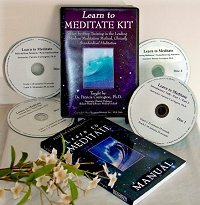Dr. Patricia Carrington's award winning meditation technique CSM (Clinically Standardized Meditation) is a clinically sensitive meditation method developed by the Medical Department of New York Telephone Company and used by numerous medical institutions, organizations, and individuals worldwide. For information click here.
The Mystery of the Mantra
Ancient Views on Revealing the Mantra
, Ph.D.
Author of “The Book of Meditation”
There are some ancient views about sharing one’s mantra that may explain some of the mystery that has traditionally surrounded this subject. These traditional views may not apply to many of us in the Western world but may nevertheless explain the secrecy stand taken by some contemporary meditation groups.
In India, for example, the traditional approach to secrecy concerning the mantra depends on the use to which a particular mantra is put. Many mantras are freely divulged in India, but these do not include the very powerful mantras used to reverberate specific energy centers in order to further the spiritual evolution of a student. Those mantras are considered part of a sacred trust and represent a special sort of communication between teacher and student.
There is a particular type of master–pupil relationship which is cemented in India by the giving of a ‘devotional’ or ‘guru’ mantra. This guru mantra ensures the discipleship. It is considered to bind master and pupil together forever, being almost in the nature of a spiritual ‘marriage contract’. A guru mantra must be kept secret at all times, it is never to be known by anyone save the master and pupil. Just as a married person would not lend her wedding ring to a friend, so the guru mantra is to be shared with no one else. If it is revealed, then master and pupil are ‘divorced’, their spiritual bond broken. Possibly those meditation organizations which demand strict secrecy concerning the mantra are following the tradition of the ‘devotional’ or ‘guru’ mantra.
As for my own position on secrecy of the mantra, when I teach CSM, I advise trainees not to tell their mantra to others often, if at all. It is best, I suggest, not to use it as an everyday word. It should be kept as a special word used exclusively to turn inward. I advise this because being discreet about the mantra is undoubtedly sound psychology. I also point out a more subtle reason for keeping one’s personal mantra confidential. In the act of meditation we are alone with our own selves in a way that doesn’t involve action or ‘doing’ in the ordinary sense. At that time we are not viewing ourselves as a person-in-action but are instead contacting the deepest core of ourselves, the inner being which simply ‘is’.
Our personal mantra therefore brings about a communion with a subtle yet profound aspect of ourselves which is often obscured by our daily whirlwind of activities. Since the mantra is a call to our deepest self, when we reveal it to another person (other than a meditation teacher) we are, in a sense, giving away part of our own essence. We all have need of an island of purely personal awareness. Our mantra gives us access to this.
Each one of us must therefore decide if we want to share the intimate experiences that our personal mantra affords us. I personally have elected to keep my mantra confidential except when discussing it with my meditation teachers. This has worked beautifully for me but you alone will decide what is best for you. I suggest that this decision be based on respect for the mantra and for your own true self, and that your guide be your wish for inner growth rather than any attempt to observe the letter of the law. This way you can attain true freedom in meditation.


